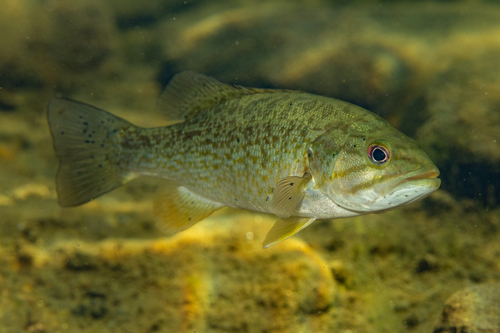
Smallmouth Bass
The Bluefin Tuna, a majestic and powerful fish, is a marvel of the marine world. Renowned for its size, speed, and endurance, it plays a crucial role in ocean ecosystems. This article delves into the fascinating life of the Bluefin Tuna, covering its habitat, behavior, life cycle, and the significant challenges it faces.
5 15 years
Lifespan
30 - 50 cm
Length
Least Concern
Conservation Status
19 km/h
Swimming speed
Carnivorous, Insectivorous
Diet
Local Migration
Migration
Appearance Overview
The Bluefin Tuna is renowned for its large, streamlined body, built for speed and endurance in the open ocean.
Color
Dark metallic blue on top, shimmering silver on the sides, and white on the belly.
Fins
Two dorsal fins, the first depressible into a groove; a series of finlets running from the second dorsal and anal fins to the tail.
Body Shape
Torpedo-shaped, with a conical snout and a crescent-shaped tail.
Length
Up to 13 feet (4 meters)
Weight
Up to 2,000 lbs (907 kg)
Diet
Carnivorous, feeding on a variety of fish, squid, eels, and crustaceans.
Feeding Behavior
Highly active predators, Bluefin Tuna use their speed and agility to hunt. They often feed in coordinated groups, herding and trapping prey.
Social Behavior
Known to form large schools, particularly during migration and spawning. They exhibit complex social behaviors and can migrate across entire oceans.
Commercial Relevance
Extremely high value, especially in sushi and sashimi markets, where its fatty flesh is considered a delicacy. This demand drives significant fishing pressure.
Conservation measures
Measures include strict fishing quotas, seasonal closures, minimum size limits, and efforts to reduce bycatch. International cooperation is crucial.
Status
Varies by species: Atlantic Bluefin Tuna - Endangered; Pacific Bluefin Tuna - Vulnerable; Southern Bluefin Tuna - Critically Endangered.
Threats
Overfishing is the primary threat, driven by high demand for sushi. Climate change, habitat degradation, and bycatch in other fisheries also pose risks.
Habitat Distribution
Depth Range
Surface waters to depths of over 3,000 feet (1,000 meters), depending on the species and life stage.
Geographic Range
Found in the Atlantic, Pacific, and Indian Oceans. Specific ranges vary by species (e.g., Atlantic, Pacific, Southern Bluefin).
Preferred Environment
Primarily pelagic, inhabiting temperate and subtropical waters. They are often found near continental shelves and slopes but also roam the open ocean.
Reproduction and Life Cycle
Breeding Habits
Spawning occurs in specific areas, such as the Mediterranean Sea and the Gulf of Mexico for Atlantic Bluefin Tuna. Spawning is often tied to water temperature.
Development Stages
Eggs hatch into larvae, which develop rapidly in plankton-rich waters. Juvenile tuna grow quickly, reaching significant size within their first year.
Fecundity
Females are highly fecund, capable of releasing millions of eggs (up to 30 million) during a single spawning season.
Maturity Age
Varies by species, but generally between 4-8 years for Atlantic Bluefin Tuna, and slightly earlier for Pacific Bluefin Tuna.
Faqs about Smallmouth Bass
How fast can Bluefin Tuna swim?
Bluefin Tuna are among the fastest fish in the ocean, capable of reaching speeds up to 43 mph (70 km/h) in short bursts.
How long do Bluefin Tuna live?
They can live up to 40 years, though this varies by species and is influenced by fishing pressure.
Is it safe to eat Bluefin Tuna?
Yes, but it's crucial to choose sustainably sourced Bluefin Tuna, if available, and be aware of the conservation status of the specific species.
Is Bluefin Tuna warm-blooded?
Bluefin tuna are warm-blooded, which means they are able to regulate its body temperature.
Do Bluefin Tuna migrate?
Yes, they are known for their impressive long-distance migrations, often crossing entire oceans to reach feeding and spawning grounds.
Copyright @ Nature Style Limited. All Rights Reserved.
 English
English